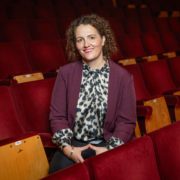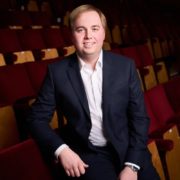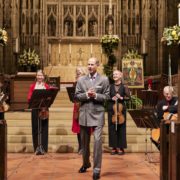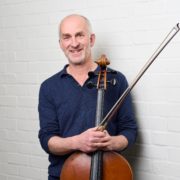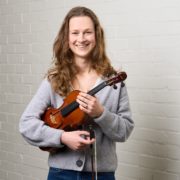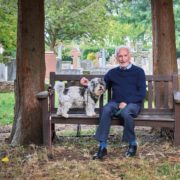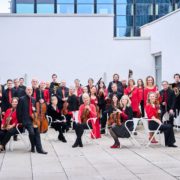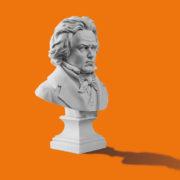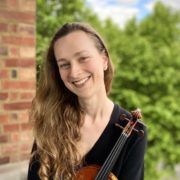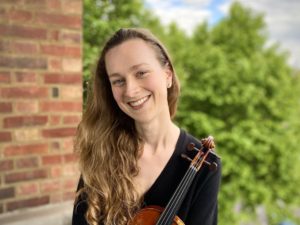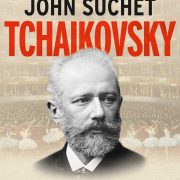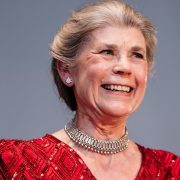Flynn Le Brocq to step down as Chief Executive of LMP
/in Blog, News /by Anna BennettToday, we announce that Flynn Le Brocq will be stepping down as our Chief Executive at the end of August 2025. Flynn has accepted an exciting new position as Director of Admissions at Uppingham School where he will continue to inspire and lead in a new capacity with a return to the education sector.
“It has been an absolute privilege to lead this wonderful orchestra. LMP’s culture is truly special and that is down to the incredible versatility and creativity of both our players and management team. Whether it has been building snow machines, taking the orchestra overseas, putting an organ in a shopping centre, sending GoPros inside instruments or pushing the boundaries of what it means to be an orchestra in the 21st century, LMP is able to turn its hand to almost anything.
I’m immensely proud of the collaborations and the artistic partnerships we’ve built, and I feel confident about the future of this extraordinary organisation. While I may be stepping away from my role as CEO, I’ll still keep in touch with LMP from the sidelines – you might even spot me raising a glass of wine at a Tasting Notes event soon.”
– Flynn Le Brocq, Chief Executive
“We are incredibly grateful for the significant impact Flynn has had during his time with LMP. His leadership has been instrumental in securing the orchestra’s financial future, streamlining its governance, and pushing us to reach ambitious goals. Thanks to his dedication and tireless work, LMP is well positioned for the future. While we are sad to see him leave, we are excited for what lies ahead for him and have no doubt he will excel in his next role.”
– Sir Robert Lechler, Chair of LMP Board
Since joining LMP in 2021, Flynn has been a transformative force, guiding LMP through a period of artistic innovation, community engagement and organisational growth. Building on the orchestra’s distinguished 76-year history, Flynn has continued to combine legacy with evolution.
Oratorio of Hope, the opening event for Croydon’s term as London Borough of Culture in 2023, pushed the orchestra’s artistic boundaries, creating a multi-genre spectacular that was later shortlisted for a prestigious Royal Philharmonic Society Award.
The following year, in celebration of our 75th anniversary, the orchestra launched 100 Faces of Croydon – a community-led photography and music project that reflected the diversity and spirit of Croydon, reinforcing our 35-year legacy as the borough’s Resident Orchestra.
“While naturally I’m sad that Flynn is leaving, the resounding feeling I have is one of immense gratitude. Flynn has led LMP with great vision, passion and agility. The collaborative spirit which has defined our work together will no doubt continue as one of his many legacies as CEO, and I’m sure will afford him great success in his next exciting venture. I look forward to fulfilling the many shared goals we have created together, and am excited at what is next to come here at LMP.”
– Jonathan Bloxham, Conductor in Residence and Artistic Advisor
“Flynn works tirelessly to promote the voices of the players, putting us at the heart of LMP. His door is always open and no problem is too small. Flynn’s infectious enthusiasm has created a team that champions its orchestra, resulting in an organisation where players and management can unite in their vision. Working with Flynn has been a pure joy. His energy, charisma and good humour will be deeply missed.”
– Jessica Coleman, Chair of the LMP Player Committee
Flynn’s time at LMP also saw the launch Tasting Notes in 2022, an innovative musical wine tasting experience that quickly became one of our most popular offerings. Under his leadership, we have forged new relationships with promoters and agents, enabling a return to international touring and the creation of a growing network of supporters in the United States – the American Friends of LMP.
“Flynn has made an enormous impact in his time at LMP. With his boundless energy, his enthusiasm, his creativity, his clear thinking and his sound instincts, he has become someone we can trust and feel confident in at all times. He has led from the front and been an inspiration to those around him. We’ll miss him enormously, but wish him all the very best in his new life.”
– Simon Blendis, LMP Leader
“Flynn has an incredible way of making everyone feel valued, respected and supported. He has done so much for LMP with his positive energy, enthusiasm and passion. I think he has made us feel that anything is possible and we should reach for the stars. He will be hugely missed.”
– Ruth Rogers, LMP Leader
We look forward to continuing the journey Flynn helped shape and wish him every success in this exciting new chapter
A full search for a new Chief Executive will commence shortly.
Sebastian Comberti to leave LMP after 40 memorable years as Principal Cello
/in Blog, News /by Anna BennettAll of us at LMP wish Sebastian Comberti a very fond farewell as he steps down as our Principal Cello in Summer 2025. Sebastian joined LMP as Principal Cello in 1983 and has played a crucial role in shaping who LMP are today.
“It’s no easy task summarising the impact Sebastian has had on LMP – not least because he has been an integral part of our orchestra for over 40 years. Sebastian’s involvement, ranging from his role as Principal Cello, contributing to our meaningful education work, programming our much loved Eastbourne residency and of course his important role on the LMP Board, is admirable and we are so grateful for his dedication. I speak for many when I say Sebastian will be much missed and we wish him the very best for the future.”
– Flynn Le Brocq, Chief Executive
“Sebastian has been an integral part of LMP for over four decades. He has been a source of inspiration to me with his musical integrity, his wealth of knowledge and experience as well as his inimitable honesty and charm. Sebastian played a vital role in steering the LMP out of murky waters and into the warmer seas it currently sails. He has curated many sensational Eastbourne programmes with informative, interesting and educational talks. I have loved playing chamber music with him and have learnt a huge amount from him. It is impossible to measure just how much he has given to LMP and the orchestra owes him a huge debt of gratitude. He will be deeply missed.”
– Ruth Rogers, Leader
“Sebastian is an LMP legend – in my mind he is synonymous with the orchestra. He has been principal cello for over 40 years, and brings his accumulated wisdom and experience to every concert, yet still arrives at rehearsals buzzing with new ideas, constantly searching out new repertoire and finding ways to refresh the old. It’s hard to imagine LMP without him!”
– Simon Blendis, Leader
“Sebastian is so full of knowledge and joy for the music he is performing, not to mention an utterly fearless cellist. It has been an amazing time being in a section with him these last 25 years. His enthusiasm for the cello, his thirst for discovering new repertoire and his stylistic awareness has been inspiring. Many good and happy memories. It is the end of an era!”
– Sarah Butcher, Cello
“Sebastian joined LMP about 40 years ago and as I was already member, I was delighted when this young, fresh and superb Cellist joined us. He then played consistently beautifully ever since. When the players took over running the orchestra in 2016, Sebastian became an invaluable member of the Board of Directors. His clear thinking, combined with his ability to offer thoughtful and often refreshing alternative perspectives, made a significant contribution to the group. Sebastian has also always been a very kind and caring person and will be missed hugely. Thank you for everything.”
– Peter Wright, Trumpet
New Appointment – Jessica Coleman as Violin 1, No.3
/in Blog, News /by Anna BennettWe’re very excited to announce that Jessica Coleman has been appointed as LMP Violin 1, No.3.
Born in Aberdeen, Jessica was fortunate enough to grow up in a musical household. Her first orchestra tour was to China when she was 9 years old, and it would seem she never looked back! Now, Jessica enjoys performing and touring with groups such as London Philharmonic Orchestra, Academy of St Martin in the Fields, City of Birmingham Symphony Orchestra and BBC Symphony Orchestra.
After attending Chetham’s School of Music, Jessica spent some time in Oslo studying with Stephan Barratt-Due, then went on to complete her undergraduate degree at the Royal College of Music with teachers Detlef Hahn and Gaby Lester. Whilst at RCM, Jessica formed a successful string quartet with friends. The quartet performed together for five years at venues such as Wigmore Hall, Kings Place, Conway Hall and the Elgar Room at the Royal Albert Hall.
Jessica feels her passions for both orchestral playing and chamber music come together in her work at LMP, and she is delighted to continue her journey with us.
A chat with Isata Kanneh-Mason and Jonathan Bloxham
/in Blog, Galleries, News /by Jessica PengBeethoven and Mendelssohn with Isata Kanneh-Mason at St John’s Smith Square
Friday 3 November 2023
Isata Kanneh-Mason piano
Jonathan Bloxham conductor
Ruth Rogers leader
London Mozart Players (LMP)
Arvo Pärt Cantus in Memorium Benjamin Britten
Anna Clyne Stride
Mendelssohn Piano Concerto No.1
Beethoven Symphony No.5
Before our concert together at St John’s Smith Square, we sat down with our soloist Isata Kanneh-Mason and conductor Jonathan Bloxham to talk about the concert, the music, and pre-concert rituals…
Isata Kanneh-Mason
- Can you tell us about your favourite moment in the Mendelssohn Piano Concerto?
It’s the opening. It’s so dramatic and exciting and I like the way the piano states its presence. Actually I also have another moment in the second movement where the piano is playing slow chords and there is a solo cello line – the harmonies there are so incredibly beautiful. - We performed the Mendelssohn two years ago with you at Cadogan Hall. How does it feel to be playing this piece together again?
It’s really lovely to perform this piece with the same group of people. I feel I have developed as a musician over the last two years so it will be nice to be able to bring something different to the performance. - Do you have a pre-concert ritual, and if so, what is it?
I try not to stick to a specific pre-concert ritual in case I don’t have time. I always make sure I stretch, warm up my fingers and drink water. I don’t tend to eat too much before going on stage as I don’t want to feel full. And I also put away my phone quite a while before a performance as well, so there are no distractions!
Jonathan Bloxham
- In your role as Conductor in Residence and Artistic Advisor of LMP, you developed the programme for this concert. Can you explain how you chose the pieces and put them together?
Programming is one of the great joys of my work as a conductor, and devising each programme comes with its own intellectual or emotional journey. The inspiration for this concert began with Mendelssohn. Not only a prodigious composer, he was also a virtuosic pianist, and as a young boy he discovered and formed a deep appreciation of Beethoven’s piano sonatas. From then on Beethoven’s music had a huge influence on his own compositions, and Mendelssohn continued to perform the master’s works throughout his life. In 1847, the year of his death, he took his final visit to Britain and performed Beethoven’s Piano Concerto No. 4. This ties in themes of London, Mendelssohn, the piano and Beethoven. Taking the second two of these we arrive at Anna Clyne’s wonderful piece – Stride – a piece for strings based on the themes from Beethoven’s Pathetique Sonata. And finally, our opening piece, Pärt’s Cantus in Memoriam Benjamin Britten is not only one of the most atmospheric openings of a concert, but it is also a little nod to the 110th Anniversary of Britten’s birth. This is a programme I adore.
- Beethoven’s Symphony No.5 is such an iconic work. How do you take on the challenge of conducting it?
It is of course an iconic work to play as well as conduct! Even just the opening is an infamously treacherous moment for us all. But what an honour it is to have the chance to perform this majestic piece with LMP. For me personally, it was in the second half of the very first symphonic concert I conducted as a student and so brings back many memories. This piece has taught me a great deal about the craft of conducting.
- You’re also conducting Mendelssohn’s Piano Concerto, which will be played by Isata Kanneh-Mason. What’s the relationship like between the conductor, soloist and orchestra when performing this piece?
Every player in the LMP is a fantastic chamber musician. And every time they perform, be it with or without a conductor, they are making chamber music. And so it is no different when a soloist joins. As a conductor in this scenario I feel my role is to help focus all our listening, to facilitate the connection between soloist and orchestra and to be a conduit for the flow of ideas between them…and adding a few of my own now and then too!
LMP, conducted by Jonathan Bloxham, play Beethoven and Mendelssohn with Isata Kanneh-Mason on 3 November 2023. Tickets can be purchased here.
Welcoming George White as our Viola No.5
/in Blog, Galleries, News /by Anna BennettGeorge grew up in the South West and was immersed in music from an early age, singing in his local church choir and later as a chorister at Salisbury Cathedral. He went on to hold a scholarship at Wells Cathedral School, later gaining a place at the Royal Academy of Music where he studied with Garfield Jackson. An alumnus of Southbank Sinfonia, George now freelances with ensembles across the UK and Europe, including us, the Philharmonia, Paraorchestra and Friends, the European Union Chamber Orchestra, La Folia and the Edington Ensemble. George was also a Monteverdi Apprentice – he worked closely with mentors from the Orchestre Révolutionnaire et Romantique and Sir John Eliot Gardiner on historical performance practice. He now performs with period groups such as the ORR, the Dunedin Consort, Oxford Bach Soloists, Eboracum, Sounds Baroque and Hampstead Garden Opera.
Our 23/24 Season Announcement
/in Blog, News /by Anna BennettIt’s our 75th birthday next year, and our 23/24 season is all about reflecting on how we’ve developed out artistic and community-based work over the years.
Flynn Le Brocq, LMP Chief Executive, commented:
“As we celebrate 75 years of music making, we’re using this season to look back on our past and particularly on our historic connection with Croydon. The Launch of the London Borough of Culture in 2023 gave us a chance to re-establish ourselves firmly in the local community and further develop our partnership with Fairfield Halls and we’re looking forward to another year of adventurous and exciting programmes.
Jonathan Bloxham, LMP Conductor-in-Residence and Artistic Advisor, commented:
“I am thrilled to share the 23/24 season with our audiences today – a programme that celebrates our wonderful musicians and the impressively wide range of work that LMP is known for. In this birthday season, it is exciting to welcome so many top soloists to share the stage with us, many of whom have a long-standing relationship with the ensemble. This season is extra special for me as I begin my first full year as Conductor-in-Residence and Artistic Advisor – I can’t wait to be back on stage with LMP in the Autumn!”
Our season opens with Story of the Fair Field (Saturday 7 October 2023, Fairfield Halls), featuring Matilda Lloyd, one of our Education Ambassadors, as the soloist for Haydn’s Trumpet Concerto in E flat. The live narrator and music in this concert, which includes Malcolm Arnold’s inaugural composition for the opening of Fairfield Halls in 1962, The Fair Field, traces through Fairfield Halls’ history as a bustling medieval fair and our history as an orchestra set up to play Haydn and Mozart.
Pianist Isata Kanneh-Mason joins us for Mendelssohn’s Piano Concerto No.1 in Beethoven and Mendelssohn (Friday 3 November 2023, St John’s Smith Square). Jonathan Bloxham also conducts our orchestra through Beethoven’s Symphony No.5, Anna Clyne’s Stride and Arvo Pärt’s Cantus in Memoriam Benjamin Britten.
Isata Kanneh-Mason commented:
“Performing with LMP is always something I look forward to and this next season is no exception when I’m thrilled to be playing Mendelssohn’s brilliant Piano Concerto No1. It’s an immediately engrossing work with its explosive start and wonderfully captivating melodies threaded through the flamboyant piano part – I can’t wait to start playing it to a live audience!”
In the leadup to Christmas, we’re presenting A Very Croydon Christmas in partnership with Fairfield Halls (Friday 8 December 2023, Fairfield Halls), featuring a festive selection of music with local choirs and performers taking to the stage.
Mozart: The Mixtape (Saturday 10 February 2024, Fairfield Halls) celebrates our birthday with a recreation of the Mozart’s ‘playlist’ concert from 1783. Pianists Imogen Cooper and Martin James Bartlett and soprano Anna Prohaska join us as the soloists for this concert. This concert will also include a selection of short videos which reflect on our legacy and look forwards to their future.
Imogen Cooper commented:
“My history with LMP goes back a long way – I won the Mozart Memorial Prize, now revived, in the late 60s, which lead me to many wonderful concerto performances with Harry Blech; I could safely say that my early Mozart performing experience came almost solely through this collaboration, and I learned a lot from it. Happily the association continued with Jane Glover, with whom I now play regularly in the US. So LMP has been only a source for the good, and I am happy to be playing with them again – not least the gorgeous K415 in C major!”
Tasting Notes, our musical wine tasting experience, returns to St John’s Smith Square with three dates this season (11 October 2023, 16 February 2024, 4 April 2024). In each event, we will pair a selection of wines with music for string quartet, accompanied by lively talks from a wine expert and LMP Leader, Simon Blendis, followed by live jazz music in the Crypt.
Continuing his 48-year-long relationship with LMP, Howard Shelley returns for another series of Mozart Explored at St Paul’s Knightsbridge (January 2024-May 2024). Howard directs the orchestra from the piano through Mozart’s final five Piano Concertos (No.23 – No.27), preceding each Concerto with an insightful talk about the music.
Our community residencies in in Upper Norwood and the South East coast continue in this season. The winning composer of our new award, the Samuel Coleridge-Taylor Prize, will have their work performed as part of Music Through the Ages (Saturday 27 January, St Johns, Upper Norwood). The prize, which is part of our Equal Play campaign, has been created to support young composers from underrepresented backgrounds.
Other concerts in our Upper Norwood series include a children’s concert, The Musical Adventures of Stan the Dog & Mabel the Cat (Saturday 8 June 2024, St John’s, Upper Norwood), and Eleanor Alberga’s Snow White and the Seven Dwarfs: A Musical Revolting Rhyme (Saturday 6 April 2024, St John’s, Upper Norwood).
We’re working with Create Music, the lead partner of the Music Education Hub in Brighton & Hove and East Sussex, to deliver education projects in the South East. Students from Create Music perform alongside us in Christmas Crackers with LMP (Thursday 14 December 2023, De La Warr Pavilion) and Marvellous Maestros includes a selection GCSE set-works to help local students prepare for their exams (Friday 22 March 2024, De La Warr Pavilion).
Full details of the season can be found on this page.
Bloch’s Building Blocks
/in Blog, Galleries, News /by Anna BennettBLOCK 1
Ernest Bloch was a Swiss-born composer who gained popularity in the 20th century. As with most composers, he went through something of an identity crisis as he tried to find his unique musical voice. We’d like to think of his life as a series of Building Blocks that led him to writing the music that you can hear in Building Blochs and Birkenstocks on Saturday 4 February at Fairfield Halls.
BLOCK 2
On 24 July 1880, Ernest Bloch was born in Geneva to Maurice and Sophie Bloch, both of whom were of Jewish heritage. The young Ernest was a keen musician, first picking up the violin aged 9 and starting to compose soon after. Ernest had a strong religious upbringing; Maurice had even intended to become a rabbi at one stage and this influence can be heard in his later music.
Ernest had a desire to travel and moved to Germany in 1903. During his Germanic years, he began his lifelong confrontation with issues of spirituality and religion. His compositional style up to this point spoke to post-romantic influences including Debussy, Mahler and Strauss but he began to break away from this from 1911-26. Commonly referred to as his ‘Jewish Cycle’ (although not titled this by the composer himself), the compositions in these years marked a turning point for the young composer and included Schelomo and ‘Prayer’.
BLOCK 3
The ‘Jewish Cycle’ put Ernest on the musical map, but the composer had his own feelings about how his music should be interpreted:
‘It is not my purpose, not my desire, to attempt a ‘reconstitution’ of Jewish music or to base my works on melodies more or less authentic. It is the Jewish soul that interests me…In my work termed Jewish…I have listened to an inner voice, deep, secret, insistent, ardent…a voice which seemed to come from far beyond myself, far beyond my parents…a voice which surged up in me upon reading certain passages in the Bible…This entire Jewish heritage moved me deeply; it was reborn in my music. To what extent it is Jewish or to what extent is it just Ernest Bloch, of that I know nothing. The future alone will decide.
BLOCK 4
Bloch is gaining more and more recognition as time goes on. He received acclaim, prizes and honour during his lifetime and his music was performed regularly. His best-known works are becoming popular with a whole host of orchestras, including us! You may not have known much about him before, but we hope you’ve enjoyed learning a bit more about the man and his music.
Mendelssohn and his Birkenstocks
/in Blog, Galleries, News /by Jessica Peng(Other shoe brands are available)
In his early twenties, Felix Mendelssohn did what most of us dream of doing and packed his bags, donned his Birkenstocks, waved goodbye to his home country Germany and set off on a grand tour of Italy. He spent nine months as a proper tourist: seeing the sights, speaking the language very badly and getting scammed by his taxi driver.
For anyone else, such an experience would be complete. But the former child prodigy Mendelssohn strove valiantly to make his holiday into a research trip. Five months into his stay, he wrote to his sister:
I now try to reflect whether I have made the best use of my time, and on every side I perceive a deficiency. If I could only compose one of my two symphonies! I must and will reserve the Italian one till I have seen Naples, which must play a part in it.
Mendelssohn’s Fourth Symphony, known as the ‘Italian’, was completed two years later. Each of its four movements corresponds to a different city he saw on his trip. For those of us unable to embark on our own continental tours, listening to Mendelssohn’s ‘Italian’ Symphony is the next best thing.
Venice to meet you
(First movement, Allegro vivace)
Mendelssohn’s first stop was Venice. His first impressions were ‘the whole country had a gay festive air, as if a Prince were expected to make his grand entry’. Prince or no prince, the people welcomed Mendelssohn anyway and his letters brim with delight at finally being in Italy.
Venice was always busy. When Mendelssohn went to the Piazza of St Mark, he observed that ‘in the twilight there is always an immense crowd and crush of people’. There was plenty to see and do as well: ‘I hurry from one enjoyment to another hour by hour,’ he wrote.
The lively opening movement recalls the busy streets that greeted Mendelssohn on his arrival, as well as the energy he expounded in his indefatigable visiting of local galleries, palaces, gardens and churches.
There’s no place like Rome
(Second movement, Andante con moto)
Mendelssohn’s stay in Rome coincided with the death of Pius VIII, who has the dubious honour of being the shortest-ruling pope of the nineteenth century. The people of Rome took the news rather lightly, telling themselves: “We shall soon get a new one”.
Mendelssohn went to St Peter’s Basilica in the Vatican where the Pope lay in state. He wrote:
Those who place themselves among the singers (as I do) and watch them, are forcibly impressed by the scene: for they all stand round a colossal book from which they sing, and this book is in turn lit up by a colossal torch that burns before it; while the choir are eagerly pressing forward in their vestments, in order to see and to sing properly.
The ‘simple and monotonous’ music he heard here no doubt influenced the slow and restrained second movement.
Going with the Flo(rence)
(Third movement, Con moto moderato)
Florence syndrome is a slightly dubious condition where people faint upon seeing sights of great beauty. In Florence, Mendelssohn frequented the Uffizi Gallery, a prime spot for aesthetically charged swooning. His own health remained intact, but he did report ‘feelings of reverence’ when sitting at his favourite spot.
Mendelssohn encountered many who had low opinions of Titian and Mozart. He found these impertinent, writing: ‘I am at all events determined to say the most harsh and cutting things to those who show no reverence towards their masters’. His own work was openly indebted to the Classical tradition that came before him.
The third movement of the ‘Italian’ Symphony is set as a stately minuet and trio in the style of Mozart. It pays homage to his musical predecessors, Renaissance painters and their shared elegant style.
See Naples and die
(Fourth movement, Saltarello. Presto)
The final stretch of Mendelssohn’s Italian journey saw him leaving Rome for the south. He applied his usual shrewdness to the new sights there, writing:
Yesterday we went to Pompeii. It looks as if it had been burnt down.
But it was in the local traditions of the more rural south that Mendelssohn found his inspiration for the finale of his ‘Italian’ Symphony. He wrote ‘lively Naples is indeed a pleasant contrast’ to ashy Pompeii and he spent many evenings there dancing the night away with village girls, with the sweet sounds of the accordion for accompaniment.
The final movement of Mendelssohn’s ‘Italian’ Symphony is based on the saltarello, an Italian folk dance popular in the south. Its relentlessly high tempo barrels towards an exuberant finish, concluding Mendelssohn’s colourful nine months in Italy.
LMP play Mendelssohn’s Symphony No. 4, ‘Italian’ at Fairfield Halls, Croydon, on Saturday 4 February 2023. Tickets can be purchased here.
by Jessica Peng
The Secret History of Beethoven’s Violin Concerto
/in Blog, Galleries /by Jessica Peng1. A tale of two procrastinators
You may know the story about Mozart’s Don Giovanni (1787). He procrastinated the overture and ended up staying up late the night before, kept awake by his wife pouring him drinks. The ink was still wet when the musicians received the scores the next day. However, such was his genius that the audience had nothing but praise: ‘Everybody, on the stage and in the orchestra, strained every nerve to thank Mozart by rewarding him with a good performance’.
Sadly, when Beethoven procrastinated on his Violin Concerto (1806), the result was not so well received. The soloist, Franz Clement, had to sight-read passages and possibly gave up with the piece altogether, choosing instead to improvise. People left the concert feeling confused at best, ‘exhausted’ at worst.
2. All press is good press?
One reviewer of the Violin Concerto asks that Beethoven stop writing music consisting of ‘unconnected and piled-up ideas’. Instead, he should ‘give us works like his first Symphonies in C and D […] which will assure him of a permanent place among the foremost composers’.
It’s easy now to laugh at this unenlightened journalist. The earliest symphonies are wonderful, but they don’t occupy our public imagination the way Beethoven’s Third, Fifth and Ninth Symphonies do. But at the time, the view that Beethoven’s music was too long, strange and complicated was not uncommon. The Violin Concerto, which was very long and very difficult, alienated the same people who had objected to the Third Symphony ‘Eroica’ – and there were plenty.
3. The Wilderness Years
The Violin Concerto didn’t sink into utter obscurity, but it was rarely performed in the four decades following its lukewarm debut. When it was performed, reviewers usually talked about how talented the soloist was to pull off such an attempt, rather than praising the concerto itself.
Positive, even glowing reviews did come along, but they were rare. For example, in 1828, the year after Beethoven’s death, the Violin Concerto was performed in Paris. One deeply moved reviewer called the concerto ‘one of the most beautiful musical conceptions one can imagine’. Another wrote slightly grudgingly: ‘the piece, we must say, was full of charm and grace’.
4. Vindication!
Beethoven avoided visiting London all his life. However, it was there that the Violin Concerto finally got its due. In 1844, a twelve-year-old Joseph Joachim played the violin as Mendelssohn conducted this concerto in Hanover Square. It was a genuinely monumental performance. It made both Joachim and the Violin Concerto famous, and Joachim would regularly play the piece for the rest of his career.
Other violinists such as Henri Vieuxtemps, Carl Flesch and Eugène Ysaÿe had their own distinctive interpretations of the Violin Concerto. By the end of the nineteenth century, the Concerto’s musical standing was indisputable. It’s worth noting that it was ultimately made famous not by critics, or even its composer, but by musicians.
Of course, there were still detractors: in 1855, a critic watched Joachim perform the concerto, then told him afterwards: “This is all very nice, but now I’d like to hear you play a real violin piece.”
5. A nineteenth-century classic
Nowadays, both Beethoven and his Violin Concerto are canonical, and safe from such criticisms. General opinion is that it redefined the relationship between soloist and orchestra, and stood at the intersection between the Classical and Romantic eras. Beethoven’s is usually considered the first of the five great nineteenth-century violin concertos, although trying to pin these down is like the world’s nichest musical chairs: other contenders include Brahms, Bruch, Lalo (for the cognoscenti), Mendelssohn, Saint-Saëns, Sibelius and Tchaikovsky.
Well, there’s nothing like a live performance to help you decide! We’re playing Beethoven’s Violin Concerto on 12 January 2023 at 7.30pm at Queen Elizabeth Hall, Southbank Centre. Our Artist-in-Residence, Leia Zhu, is our soloist for this piece.
© Jessica Peng 2022
A Deep Dive Into Handel’s ‘Messiah’
/in Blog, Galleries, News /by Jessica PengQuick: name a choral piece! Did you say Handel’s ‘Messiah’?
It’s one of the most famous pieces of classical music ever, but how much do you really know about its origins and history? We asked Thomas Allery, organist and harpsichordist, some questions about the original ‘Messiah’ and its influence today. Read on to be enlightened and informed…
‘Messiah’ was originally orchestrated for two trumpets, timpani, two oboes, two violins, viola and basso continuo. Subsequent performances have been much bigger, with orchestras numbering well into the hundreds. Can you say a little about the size and scope of ‘Messiah’?
‘Messiah’ is one of those pieces of choral/orchestral music which can work successfully with almost any size and combination of instrumental forces, and the performance history of the piece shows the complete range! Even today, performances range in size hugely from large scale performances with large choruses and a corresponding large orchestra (often in large venues), to smaller, more intimate versions. It says something about the piece that it is so successful and appealing to audiences in almost any configuration.
In fact, my own first experience of ‘Messiah’ was at a local ‘come and sing’ performance with organ only – also very successful, but a bit of a work out for one organist! The almost entirely unbroken performance tradition of the work means that it has always been able to expand or contract to suit venues and ensembles, not to mention changing tastes over the centuries…
For instance, in the nineteenth century, amateur choral societies flourished across England, and with that, the tradition of large scale performances grew. At this time, new orchestrations and arrangements grew out of the practical needs for new bigger performance forces, including a new orchestration by Mozart and many arrangements for organ accompaniment. Mid nineteenth-century performances in London, such as those at Crystal Palace, had choirs of several thousand voices and huge orchestras numbering 500!
These days, many performances are of a smaller number of singers and players which can be a little more intimate and with a chamber feel – including with directors playing the continuo themselves.
We think of ‘Messiah’ as an oratorio, but Handel had spent much of his career writing Italian operas until this point. Where does ‘Messiah’ sit amongst the musical genres of its time?
That’s an interesting question as it gets us into the heart of London’s musical life in the middle of the eighteenth century. Handel made huge success as a composer of Italian opera. He travelled to Italy, the heart of the operatic world, early in his life and then had great success with Italian operas such as ‘Agrippina’ (1709) and ‘Rinaldo’ (1711). London was a great melting pot of styles when Handel settled here permanently in 1712, and yes, Italian opera was very popular at this time (also think about the orchestras in the opera houses – full of players and budding composers from across Europe).
Despite this success, Italian opera had always had its highs and lows in London but it began to have severe difficulties in the 1720s – this was mainly because audiences preferred works in English and with a less ornate style, and there was also difficulty in retaining Italian singers to sing them. Composers have always had to move with the times and write what their audiences wanted to hear, and Handel turned his attention to oratorios. Handel had already written Italian oratorios in Rome, and his first English oratorio was in 1718 (‘Esther’). His other oratorios (now also regularly performed) such as ‘Saul’ and ‘Israel in Egypt’ were written just before ‘Messiah’, and also had librettos by Charles Jennens, so they already had a close and successful working relationship. Jennens proposed his libretto for ‘Messiah’ expressing that he hoped that Handel would write a work as powerful as the text demanded – and he did.
‘Messiah’ was premiered in Dublin, but the London performance was more controversial because it was performed in a secular venue, even though its text is drawn from scriptures. When it was advertised, it was called ‘a sacred oratorio’ rather than ‘Messiah’, so we have a glimpse into a world in which the labelling of a new piece, and signalling its genre was important. The libretto is based on themes rather than plot-driven like an opera. So, in terms of genre, it is definitely an oratorio, but written by the hand of a composer who could lend his hand to so many genres, and we often hear the same unmistakable style as we might hear in the opera house.
The original ‘Messiah’ featured some celebrity soloists (Susannah Cibber, the alto). What is the relationship like between soloists and the chorus throughout the piece?
The role of the chorus seems to change a little through the piece. The chorus does not interact with the soloists as they might in an opera, but Handel seems to use the chorus to reinforce important lines within the scriptures. We should remember that the choice of solo voice or chorus is in itself a decision and an interpretation of the text. At some moments, such as in ‘Hallelujah’ or ‘Worthy is the Lamb’ they seem to represent the voice of the whole world united in praise and thanks, whilst in the middle section, the chorus could be seen to have the role of the crowd, more like in Bach’s ‘Passions’. The first time the chorus sings in ‘And the Glory of the Lord shall be revealed’ is an incredibly powerful moment: coming from the stormy overture into the promises of the opening tenor movements and then into the light. To me, the lightness, the rhythm, and imitations in this movement represent light coming into the world and illuminating everything. There, the sound of the chorus opens up the soundscape to represent the light. Throughout the piece, the placement of the chorus movements punctuate the piece perfectly, and drive the drama on, all adding to the narrative.
Can you explain why the ‘Hallelujah’ chorus is so catchy, memorable and popular?
It’s got to be the marriage of the text with music. From the outset, Handel captures the natural rhythm and shape of the most joyful word in our language “Hallelujah”. When you say this word aloud, the rhythm of the text is exactly what Handel notates. When you hear this piece, it is as though you are singing it too – it’s infectious.
The movement has a masterful use of harmonic tension and progression. Here Handel is almost like a film composer, pacing the phrases and progressions so you somehow know where it is going, but in which the listener is taken on a journey. The long progression up from ‘King of Kings’ feels like a huge progression through several keys, each with a particular harmonic colour. However many times you have heard it or performed it, it’s always an amazing movement which takes on a different life each time.
And finally, why do you think ‘Messiah’ is still so popular today?
There are many answers for this question! Where to start? The piece was designed to be accessible, direct in its expression, and powerful for a London audience, and this legacy and connection seems to live on. It’s a work that has not been forgotten.
It’s interesting here to think about the charity tradition surrounding the piece which I think contributes to its popularity even today. The first performance in 1742 (in Dublin) was in support of three charities: for prisoners, for a hospital, and for an infirmary. The compositional circumstances of a piece of music can always be felt somehow, even centuries on. You can feel the devotion, the positivity and the values behind it – in that regard perhaps different to in Handel’s operas which were written as commercial entertainments. Handel had a close relationship with the Foundling Hospital and started the annual performances there in 1750, and which continued after his death with John Stanley, and then eventually developed through the nineteenth century into a history of associating music performances with charitable giving, especially at Christmas. Somehow the balance in terms of themes and music lends itself so well to new audiences too. There is just the right balance between solos and chorus, between keys, between light and dark, between recitative and aria, and so on.
Then there is its association with amateur music making across the years. For any choir, Messiah is a great and satisfying challenge, and one that doesn’t get tired. Many, many people have therefore performed at least extracts from it. How many other major works is that the case with?
Then I guess there is the seasonal element! Messiah is closely associated with Christmas, and choirs are more popular at Christmas time, with lots of people enjoying joining in with carols and hearing music which tells the Christmas story.
Hear LMP perform ‘Messiah 360’, our version of the classic with a twist, on Saturday 17 December 2022 at Fairfield Halls, Croydon. Thomas Allery joins us as the harpsichordist and director for this concert. Tickets and more information can be found here.
The Significance of Hiawatha
/in Blog /by Jessica PengIt is hard to consider Coleridge-Taylor’s masterwork The Song of Hiawatha, the first part of which LMP will be performing in October, without reference to the spectacular performances that were for many years an annual London ritual. Such performances, with their clear overtones of cultural appropriation and the doctrine of the “noble savage”, would be regarded as wildly inappropriate now. But were they what Coleridge-Taylor himself had intended? How did he see the character of Hiawatha? And how should we view his work today?
Initially produced in 1924, (12 years after Coleridge-Taylor’s death), by the impresario T.C. Fairbairn and the Royal Choral Society, Hiawatha was staged in the vast setting of the Royal Albert Hall with scenery, backdrops and costumes. The composer’s daughter Avril took part on at least one occasion, singing the part of Minnehaha, while her brother (also named Hiawatha) conducted the ballet sections of the performance. In that first year six performances were given, and these proved so successful that the event was repeated every year after until 1939 (the only exception being 1926). From 1925 onwards, the role of the Medicine Man in the third part (Hiawatha’s Departure) was played by a Mohawk Chief.
Where it all began
Though Fairbairn’s productions began in the 1920s, the story of Hiawatha goes back much further to Longfellow’s original poem The Song of Hiawatha which was published in 1855.
Longfellow drew on material collected by American geographer, geologist, and ethnologist Henry Schoolcraft, who, though a pioneer as an ethnologist, was severely inaccurate by modern standards; among his errors seems to have been a conflation of two historical characters from different Native American tribes – the Iroquois chief Hiawatha and an Ojibwe folk hero named Manabozho (Schoolcraft’s wife was of Ojibwe descent). Longfellow went further, making his titular hero the centre of stories that had originally been about other characters, and inventing new stories entirely; the whole of the relationship between Hiawatha and Minnehaha (on which the Wedding Feast is based) is Longfellow’s own, and totally untrue to known Native American familial practice. In addition, in place of the resourcefulness that characterises the original characters, Longfellow’s Hiawatha becomes an elegiac, renunciatory figure, the archetypal noble savage, who willingly yields his primacy among his people to the incoming “pale-faces” and their religion. This was far from an arbitrary decision by the poet: Longfellow had a vision of creating an epic that would link his people – white Americans – to the land they were now claiming as their own, and therefore needed to portray Native Americans as a relic of the past, a dying culture into whose place white settlers could rightfully move. Having given his blessing to colonialism Hiawatha thus departs into the sunset, into legend and the past – where white America would perhaps have preferred its aboriginal forerunners to have remained.
If one were seeking to write a Hiawatha epic now, it would not be acceptable to do what Longfellow did. Nevertheless, by the standards of the time it was a relatively sympathetic approach – some critics felt he had been too lenient in his treatment of Native Americans. And though it was not the first attempt by a white poet to use Native American folklore as a basis, it was far and away the most successful. As a result, it achieved two things. It brought an awareness of Native American culture to a wider audience than had experienced it before (and, paradoxically, stimulated some Native American groups to claim their cultural heritage more strongly and vocally). And it presented such culture to that wider audience as capable of epic treatment.
Samuel and Hiawatha
Longfellow’s Hiawatha, to some extent a lonely outsider among his people, is also a leader of a culture that is about to undergo seismic shock as it encounters Christian Europeans. Coleridge-Taylor was the son of a Sierra Leonean, a black man growing up in London and a musician striving to be true to his roots and yet succeed on a Eurocentric stage. He could be reasonably assured of a fair hearing in musical circles; he could also expect to be catcalled in the street. He may well have identified with the ambivalence that Hiawatha embodied.
It is noteworthy that when in 1899 Coleridge-Taylor wrote an Overture to the Hiawatha cycle, the main theme is drawn not from any Native American source but from an American negro spiritual, Nobody Knows the Trouble I’ve Seen. He had learned the melody from the performances of the Fisk Jubilee Singers, who under their charismatic leader John Frederick Loudin had travelled the globe performing Black American choral music. The struggles of Native and Black Americans alike for integrity and dignity were thus treated as similar, by a black Englishman half a world away struggling for the same.
Samuel and America
The phenomenal success of Hiawatha’s Wedding Feast in 1898 did not only establish Coleridge-Taylor as a major force in English musical life. Its effect in America was perhaps even more profound. Post-Reconstruction, Black Americans were faced both with pushback against the freedoms so hard and bitterly won, and the question of how the race should comport itself in the new world it inhabited. Opinion was divided between those who felt that Black Americans should proceed with great caution and modesty (epitomised in Booker T. Washington’s adage “cast down your bucket where you are”) and those who felt that greater progress was possible but would need to be justified by achievement. The great Black intellectual W.E.B Dubois opined memorably that “the Negro Race is going to be saved by its exceptional men” in his book The Souls of Black Folk – a book Samuel read.
Coleridge-Taylor, with Hiawatha, catapulted himself into the ranks of those exceptional men: an artist of African descent succeeding on equal terms in the heart of what was deemed then to be the greatest empire existing. Demand for him to visit America was almost immediate, and persistent. The first performance of Hiawatha took place in Boston in 1900. Other places soon followed suit. An all-Black choral society bearing Coleridge-Taylor’s name was founded in 1901 in Washington D.C, through the efforts of Mamie Hilyer, who with her husband had visited Samuel in London. She was instrumental in persuading in 1904 to travel to the United States to conduct the Hiawatha trilogy. Samuel was insistent that he would only come if the work were performed with orchestra; but there was no all-black orchestra then in existence of the requisite quality. Eventually the Marines Band, which was nominally free from colour prejudice, was engaged, and Samuel became the first Black musician to conduct white American players – another epochal achievement. One of his soloists was Harry Burleigh, the Black singer who had worked with Dvořák. During his visit he also conducted some Choral Ballads, specially written for the purpose. Their texts were drawn from a small volume called Poems on Slavery, written in 1842 and published in defiance of backlash. The poet was, again, Longfellow. At the end of Coleridge-Taylor’s visit the Washington choir presented him with a silver cup, engraved with Longfellow’s words from the conclusion of Hiawatha’s Departure:
It is well, for us, O brother
That you come so far to see us.
Samuel Coleridge-Taylor was to visit the United States twice more. He spent the rest of his short life increasingly committed to proclaiming his African heritage through the Western European music he wrote. In this he was a role model for Black American composers such as William Grant Still and Florence Price. But he would not have had so profound an impact had he not written in the first place a work that enraptured audiences wherever it was heard.
©2022 Martin Smith
The Significance of Hiawatha
/in Blog /by Anna BennettIt is hard to consider Coleridge-Taylor’s masterwork The Song of Hiawatha, the first part of which LMP will be performing in October, without reference to the spectacular performances that were for many years an annual London ritual. Such performances, with their clear overtones of cultural appropriation and the doctrine of the “noble savage”, would be regarded as wildly inappropriate now. But were they what Coleridge-Taylor himself had intended? How did he see the character of Hiawatha? And how should we view his work today?
Initially produced in 1924, (12 years after Coleridge-Taylor’s death), by the impresario T.C. Fairbairn and the Royal Choral Society, Hiawatha was staged in the vast setting of the Royal Albert Hall with scenery, backdrops and costumes. The composer’s daughter Avril took part on at least one occasion, singing the part of Minnehaha, while her brother (also named Hiawatha) conducted the ballet sections of the performance. In that first year six performances were given, and these proved so successful that the event was repeated every year after until 1939 (the only exception being 1926). From 1925 onwards, the role of the Medicine Man in the third part (Hiawatha’s Departure) was played by a Mohawk Chief.
Where it all began
Though Fairbairn’s productions began in the 1920s, the story of Hiawatha goes back much further to Longfellow’s original poem The Song of Hiawatha which was published in 1855.
Longfellow drew on material collected by American geographer, geologist, and ethnologist Henry Schoolcraft, who, though a pioneer as an ethnologist, was severely inaccurate by modern standards; among his errors seems to have been a conflation of two historical characters from different Native American tribes – the Iroquois chief Hiawatha and an Ojibwe folk hero named Manabozho (Schoolcraft’s wife was of Ojibwe descent). Longfellow went further, making his titular hero the centre of stories that had originally been about other characters, and inventing new stories entirely; the whole of the relationship between Hiawatha and Minnehaha (on which the Wedding Feast is based) is Longfellow’s own, and totally untrue to known Native American familial practice. In addition, in place of the resourcefulness that characterises the original characters, Longfellow’s Hiawatha becomes an elegiac, renunciatory figure, the archetypal noble savage, who willingly yields his primacy among his people to the incoming “pale-faces” and their religion. This was far from an arbitrary decision by the poet: Longfellow had a vision of creating an epic that would link his people – white Americans – to the land they were now claiming as their own, and therefore needed to portray Native Americans as a relic of the past, a dying culture into whose place white settlers could rightfully move. Having given his blessing to colonialism Hiawatha thus departs into the sunset, into legend and the past – where white America would perhaps have preferred its aboriginal forerunners to have remained.
If one were seeking to write a Hiawatha epic now, it would not be acceptable to do what Longfellow did. Nevertheless, by the standards of the time it was a relatively sympathetic approach – some critics felt he had been too lenient in his treatment of Native Americans. And though it was not the first attempt by a white poet to use Native American folklore as a basis, it was far and away the most successful. As a result, it achieved two things. It brought an awareness of Native American culture to a wider audience than had experienced it before (and, paradoxically, stimulated some Native American groups to claim their cultural heritage more strongly and vocally). And it presented such culture to that wider audience as capable of epic treatment.
Samuel and Hiawatha
Longfellow’s Hiawatha, to some extent a lonely outsider among his people, is also a leader of a culture that is about to undergo seismic shock as it encounters Christian Europeans. Coleridge-Taylor was the son of a Sierra Leonean, a black man growing up in London and a musician striving to be true to his roots and yet succeed on a Eurocentric stage. He could be reasonably assured of a fair hearing in musical circles; he could also expect to be catcalled in the street. He may well have identified with the ambivalence that Hiawatha embodied.
It is noteworthy that when in 1899 Coleridge-Taylor wrote an Overture to the Hiawatha cycle, the main theme is drawn not from any Native American source but from an American negro spiritual, Nobody Knows the Trouble I’ve Seen. He had learned the melody from the performances of the Fisk Jubilee Singers, who under their charismatic leader John Frederick Loudin had travelled the globe performing Black American choral music. The struggles of Native and Black Americans alike for integrity and dignity were thus treated as similar, by a black Englishman half a world away struggling for the same.
Samuel and America
The phenomenal success of Hiawatha’s Wedding Feast in 1898 did not only establish Coleridge-Taylor as a major force in English musical life. Its effect in America was perhaps even more profound. Post-Reconstruction, Black Americans were faced both with pushback against the freedoms so hard and bitterly won, and the question of how the race should comport itself in the new world it inhabited. Opinion was divided between those who felt that Black Americans should proceed with great caution and modesty (epitomised in Booker T. Washington’s adage “cast down your bucket where you are”) and those who felt that greater progress was possible but would need to be justified by achievement. The great Black intellectual W.E.B Dubois opined memorably that “the Negro Race is going to be saved by its exceptional men” in his book The Souls of Black Folk – a book Samuel read.
Coleridge-Taylor, with Hiawatha, catapulted himself into the ranks of those exceptional men: an artist of African descent succeeding on equal terms in the heart of what was deemed then to be the greatest empire existing. Demand for him to visit America was almost immediate, and persistent. The first performance of Hiawatha took place in Boston in 1900. Other places soon followed suit. An all-Black choral society bearing Coleridge-Taylor’s name was founded in 1901 in Washington D.C, through the efforts of Mamie Hilyer, who with her husband had visited Samuel in London. She was instrumental in persuading in 1904 to travel to the United States to conduct the Hiawatha trilogy. Samuel was insistent that he would only come if the work were performed with orchestra; but there was no all-black orchestra then in existence of the requisite quality. Eventually the Marines Band, which was nominally free from colour prejudice, was engaged, and Samuel became the first Black musician to conduct white American players – another epochal achievement. One of his soloists was Harry Burleigh, the Black singer who had worked with Dvořák. During his visit he also conducted some Choral Ballads, specially written for the purpose. Their texts were drawn from a small volume called Poems on Slavery, written in 1842 and published in defiance of backlash. The poet was, again, Longfellow. At the end of Coleridge-Taylor’s visit the Washington choir presented him with a silver cup, engraved with Longfellow’s words from the conclusion of Hiawatha’s Departure:
It is well, for us, O brother
That you come so far to see us.
Samuel Coleridge-Taylor was to visit the United States twice more. He spent the rest of his short life increasingly committed to proclaiming his African heritage through the Western European music he wrote. In this he was a role model for Black American composers such as William Grant Still and Florence Price. But he would not have had so profound an impact had he not written in the first place a work that enraptured audiences wherever it was heard.
©2022 Martin Smith
Welcoming Jessica Coleman to our violin section
/in Blog, Galleries, News /by Anna BennettWe are delighted to welcome Scottish violinist Jessica Coleman as second violin in our orchestra.
Jessica is a sought-after chamber and orchestral musician based in London. She began learning the violin aged four and went on to study at Chetham’s School of Music and the Royal College of Music with Jan Repko, Detlef Hahn and Gaby Lester. During her time at the RCM, Jessica formed a successful string quartet with which she performed at such venues as Wigmore Hall, Kings Place, and the Royal Albert Hall. Jessica remains passionate about chamber music and enjoys pairing her orchestral work with exciting ensemble-based projects.
In 2017, Jessica was a member of Southbank Sinfonia, and has since built up a successful freelance career working with many of the top chamber and symphony orchestras across the country.
Jessica believes in making music widely accessible and has been particularly inspired by our strong community presence. She has loved working with us over the past year and is delighted to be joining as a permanent member.

